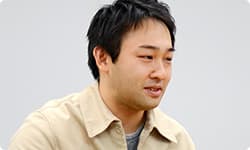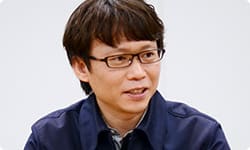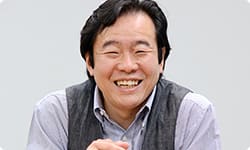The Go-go Track
I'd like to ask about your individual specialties now: programming and music. Shiraiwa-san, what was a programming challenge that you faced?
Achieving 60 frames per second (FPS).16 And the Nintendo 3DS system requires two images, one for the right eye and one for the left. 16. 60 frames per second: Animation using 60 image frames per second. The more frames there are, the smoother the animation.
You have to make two pictures.
In addition to that, there's the bottom screen, so we have to do three. That alone made the burden bigger than ever before, but the hardware was new, and the planners were saying, "We want to put in more characters," and the designers were saying, "We want the visuals to look better." It was our first time to handle the hardware, so achieving that balance was awfully hard. And it was the first time to connect eight Nintendo 3DS system, so we had to try a number of things with regard to how much processing capacity to use.
Nonetheless, we were able to push toward our targets without wavering from our goals of 3D, 60 FPS, and eight-player battles.
The prioritization of your goals was clear, so in the end you were able to achieve a good balance.
That's right. When all sorts of ideas came up, we moved forward in consideration of the question "Can we do that at 60 FPS?"
Whether it runs at 60 FPS actually has a big influence on the impression the game makes when you play it.
I've been working on Mario Kart ever since the days of the Nintendo GameCube system, but it was hard to make everything fit into 60 FPS. No one agrees with me, but images as 60 FPS are brighter.
They do move in a more livelier way.
It's like the screen is shining. It's bright.
(laughs)
I know that it isn't actually shining, but feeling-wise, it shines differently. (laughs)
Yeah. (laughs) Maybe I'm just glad we could do it at 60 FPS. At 30 FPS, it might have seemed dark!
It's funny how you're a programmer but you're saying unscientific things. (laughs) It may be a subjective thing, but there is no doubt that it makes a completely different impression. While keeping 60 FPS, some said they wanted the visuals to look better. How did you adjust to those conflicting demands?
There's an old method that someone who used to work on the Mario Kart series told me. He said that once you make something at 60 FPS, improve your programming so as not to surpass that.
During development, you stick to 60 FPS.
Right. I put in impossible requests to (Masayoshi) Ishikawa-san.17 He said, "I want to make gorgeous character models and try out all sorts of facial expressions," but I said, "First make eight-person races run at 60 FPS."
Then we did all kinds of experiments about what kinds of expressions could be done. Toward the middle of development, we made quite a lot of adjustments to the courses that Retro Studios had made. With regard to Wuhu Island18 in particular, the original island that served as the basis was large, so there were a lot of adjustments.
17. Masayoshi Ishikawa: Software Development Department, Entertainment Analysis & Development Division, Nintendo. He was lead artist of the characters and karts in Mario Kart 7. Appeared in Iwata Asks: Mario Kart 7 : Joint Development with Retro Studios.
18. Wuhu Island: The setting of Wii Sports Resort™.
Usually, you do three laps and then there's the goal, but the goal on Wuhu Island is after a single lap. There would be a lot of landform data, so if you didn't process it right, you wouldn't be able to maintain 60 FPS.
It's a busy course graphically as well, so processing was getting heavy. At that time, Morimoto-san took a business trip to Retro Studios. They adjusted the graphics there and at the same time we improved the programming here. Konno-san was worried, so just about every day he would say, "How is it coming?" (laughs)
That's because I was the one who suggested putting in Wuhu Island. I was glad when it worked out all right in the end.
It truly is good that it's in there! (laughs) Let's move on to Nagata-san. What is important for the music in Mario Kart? What did you pay attention to?
I pay attention to the sound of the engines every time. I also try to make sure the background music doesn't simply sound like racing-game music. It's like Mario's blood runs through Mario Kart. Luckily, a lot of fans enjoy the music from past Mario Kart games, so this time as well I tried to make memorable music.
Is that another tradition of the Mario Kart series?
Well, no one told me to, but…
It's not like the programmers, who had to make it run at 60 FPS.
Right. There's nothing like that, but I have that idea.
You've been making Mario Kart ever since Mario Kart 64.19 19. Mario Kart 64: An action-racing game released for the Nintendo 64™ system in February 1997.
Right. Mario Kart 64 was my first job as a new guy. After that, I helped with Mario Kart: Double Dash!!, making this my third game in the series. After 15 years, this was a chance for revenge, so to speak. We needed music for the classic courses, so I pulled out the old data, and looking at it now was embarrassing. (laughs)
So you preserved the atmosphere of the old background music but secretly polished it up.
Right, that's what I did. Memory revision.
But like Nagata-san says, there are all kinds of reactions in this game, not just racing, so I think the role played by sound is a big one.
With regard to the new elements in the air and underwater, I wanted to do something with the sound. The atmosphere of the background music changes, so I want people to enjoy that.
You can hear the wind up in the air.
Yeah. I wanted that to stand out. In some places, you can hear birds chirping.
Underwater, you hear sounds like you're moving underwater. It sounds so natural that if you don't focus, you won't notice anything has been done. It's amazing that nothing feels unnatural.
I made a lot of adjustments together with the sound programmers, but it's so natural that you hardly notice! (laughs) I suppose that's a good thing, though.
Another simple thing is how when you're racing in first place, the background music livens up. Like zoon-chaka zoon-chaka! We call it the "Go-go Track." (laughs)
You can hear it when you're in first?
Yeah. The groove gradually picks up, so you naturally realize you're in first.
Oh, so that's why when I'm in first I feel more elated than in previous Mario Kart games. The background music was livening up. I hadn't noticed that either!
That's how natural it is. I think some of the staff members never noticed! (laughs)
The music in Mario Kart Wii changed when you went underwater. In order to recreate that this time, we put in a way for the music to change. We wanted to use it for something else and thought about cheering on the person in first. And it came with a beneficial side effect. When the driver in second starts to catch up, the "Go-go Track" gradually fades. In other words, you can tell the distance without looking at the bottom screen.
And when a shell hits you, the "Go-go Track" suddenly ends, doubling your disappointment. I think that's another effect! (laughs)



